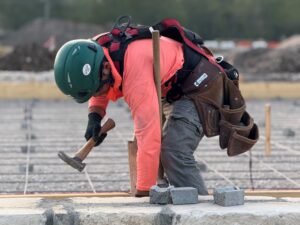Our BCS Safety Culture is more than just developing new policies and procedures and creating new training programs. It is more than complying with OSHA rules and hiring more safety professionals. The BCS Safety culture is how every worker on every BCS job site does their job to prevent accidents.

We like to think that we don’t just have six safety professionals at BCS, everyone at BCS is a safety professional. Our Safety Culture will continue to develop based on client requirements, changes in the OSHA standard and studying our own injury and first aid trends. Making our safety culture even stronger will depend on these behaviors:
- We expect improvement, not perfection. I like to say, “We don’t have to be perfect, we just have to be better today than we were yesterday.” People make mistakes, people get hurt. No matter how well trained our employees are, distractions, short cuts, being in a hurry and other behaviors cause accidents. We must praise and encourage workers who identify problems and suggest ideas for working more safely.
- We cannot tolerate short cuts. Many of our injury accidents and safety violations in previous years were due to bad habits that just eventually caused an injury. Not wearing gloves, using sawhorses, not conducting JHAs and operators not using ground guides to name a few. When we recognize a bad habit that puts safety at risk, we have to say something before an accident happens. The safety team cannot be everywhere at every job. Each employee should model the phrase “See something, say something and know that every worker has the authority to stop work if they see a hazard.”
- We encourage everyone to be a safety professional. Who is more likely to see safety issues first, the safety guy or 35 workers at The Dripping Springs Elementary School or LBJ job sites? Only when every employee at BCS feels a sense of commitment to safety, that safety is their job too and that they won’t be punished for making a mistake, only then can jobsite safety continue to improve.
- We understand the role of the Safety Team. We do not want to make the mistake of having 5 or 6 safety professionals responsible for the safety of 300 workers. This puts the responsibility for safety in the hands of one person or a small team. And when the safety team is assigned to only bigger jobsites of 25 or more employees, what happens to BCS safety program when 5 or 10 workers are on a jobsite? When everyone is part of the safety team, this separates the function from the people and helps reduce the risk of injury accidents.
- We need to study our near misses. Since September of 2023, we have had no recordable incidents. This is a great accomplishment, no doubt. In 2022, when we had 14 First Aid Injuries, most of which were finger lacerations and smashed fingers, why so many? We studied the trends and have implemented pinch point training, new cut proof gloves, jobsite posters about hand safety, now we have virtually no finger injuries? What will our injury trends be in 2025?
Reducing risk means more training, both in safety and operations and documenting this training. It means conducting job site inspections and citing violations. It also means correcting these violations and following up on these corrections to make sure that they are being implemented after the initial implementation. Training new workers is critical to risk management, and they must be welcomed and trained as they enter our safety culture. Our leaders have to coach, mentor and teach. We must focus on what we can control and like Ben Horton always says,” We are always better when we work as a team.”
To see our past concrete work, visit our portfolio and get a quote from us today.

